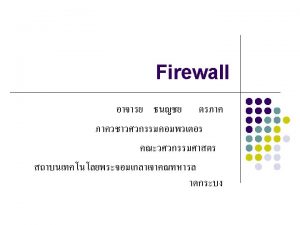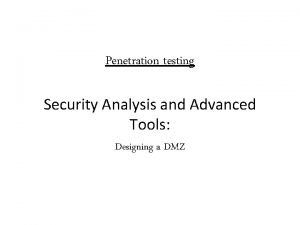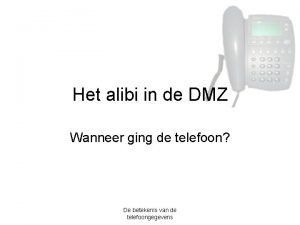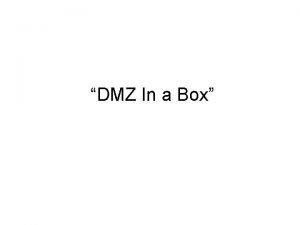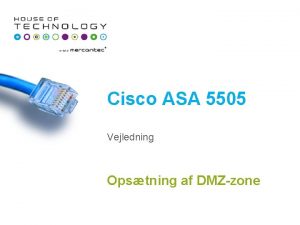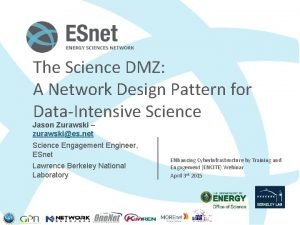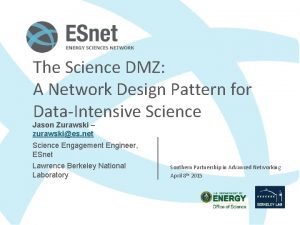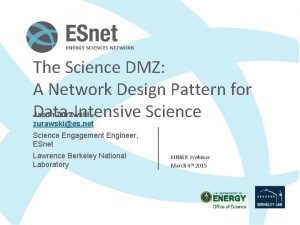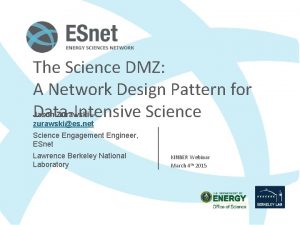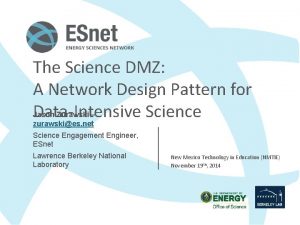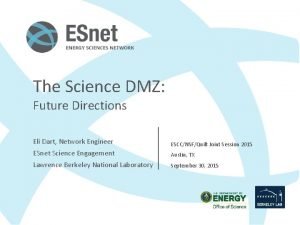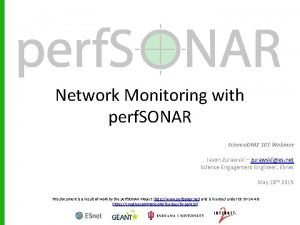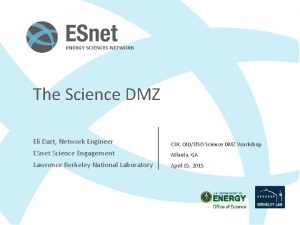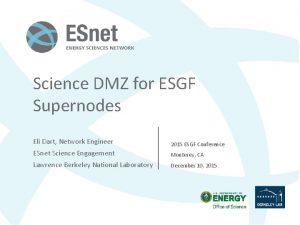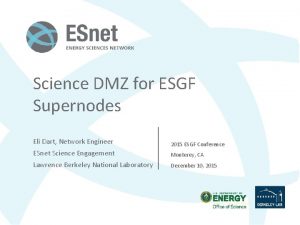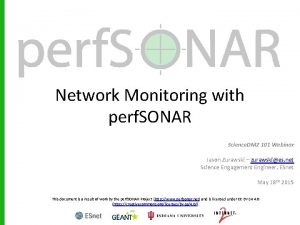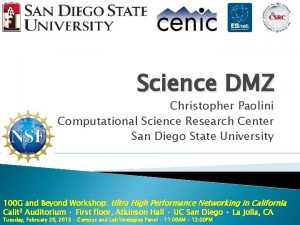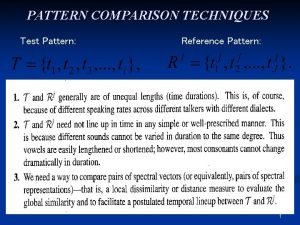The Science DMZ A Network Design Pattern for













































- Slides: 45

The Science DMZ: A Network Design Pattern for Data-Intensive Science Jason Zurawski – zurawski@es. net Science Engagement Engineer, ESnet Lawrence Berkeley National Laboratory Southern Partnership in Advanced Networking April 8 th 2015

ESnet at a Glance • High-speed national network, optimized for DOE science missions: – connecting 40 labs, plants and facilities with >100 networks (national and international) – $32. 6 M in FY 14, 42 FTE – older than commercial Internet, growing twice as fast • $62 M ARRA in 2009/2010 grant for 100 G upgrade: – transition to new era of optical networking – world’s first 100 G network at continental scale • Culture of urgency: – 4 awards in past 3 years – R&D 100 Award in FY 13 – “ 5 out of 5” for customer satisfaction in last review – Dedicated staff to support the mission of science 2 – ESnet Science Engagement ( engage@es. net) - 6/5/2021

Network as Infrastructure Instrument ESnet Vision: Scientific progress will be completely unconstrained by the physical location of instruments, people, computational resources, or data. 3 – ESnet Science Engagement ( engage@es. net) - 6/5/2021 © 2015, Energy Sciences Network

Overview • Science DMZ Motivation and Introduction • Science DMZ Architecture • Data Transfer Nodes & Applications • Science DMZ Security • User Engagement • Wrap Up 4 – ESnet Science Engagement ( engage@es. net) - 6/5/2021 © 2015, Energy Sciences Network

Motivation • Science & Research is everywhere – Size of school/endowment does not matter – there is a researcher at your facility right now that is attempting to use the network for a research activity • Networks are an essential part of data-intensive science – Connect data sources to data analysis – Connect collaborators to each other – Enable machine-consumable interfaces to data and analysis resources (e. g. portals), automation, scale • Performance is critical – Exponential data growth – Constant human factors (timelines for analysis, remote users) – Data movement and analysis must keep up • Effective use of wide area (long-haul) networks by scientists has historically been difficult (the “Wizard Gap”) 5 – ESnet Science Engagement ( engage@es. net) - 6/5/2021 © 2015, Energy Sciences Network

Big Science Now Comes in Small Packages … …and is happening on your campus. Guaranteed. 6 – ESnet Science Engagement ( engage@es. net) - 6/5/2021 © 2015, Energy Sciences Network

Understanding Data Trends 7 – ESnet Science Engagement ( engage@es. net) - 6/5/2021 © 2015, Energy Sciences Network

Data Mobility in a Given Time Interval (Theoretical) These tables available: http: //fasterdata. es. net/fasterdata-home/requirements-and-expectations/ 8 – ESnet Science Engagement ( engage@es. net) - 6/5/2021 © 2015, Energy Sciences Network

The Central Role of the Network • The very structure of modern science assumes science networks exist: high performance, feature rich, global scope • What is “The Network” anyway? – “The Network” is the set of devices and applications involved in the use of a remote resource • This is not about supercomputer interconnects • This is about data flow from experiment to analysis, between facilities, etc. – User interfaces for “The Network” – portal, data transfer tool, workflow engine – Therefore, servers and applications must also be considered • What is important? Ordered list: 1. 2. 3. Correctness Consistency Performance 9 – ESnet Science Engagement ( engage@es. net) - 6/5/2021 © 2015, Energy Sciences Network

TCP – Ubiquitous and Fragile • Networks provide connectivity between hosts – how do hosts see the network? – From an application’s perspective, the interface to “the other end” is a socket – Communication is between applications – mostly over TCP • TCP – the fragile workhorse – TCP is (for very good reasons) timid – packet loss is interpreted as congestion – Packet loss in conjunction with latency is a performance killer • We can address the first, science hasn’t fixed the 2 nd (yet) – Like it or not, TCP is used for the vast majority of data transfer applications (more than 95% of ESnet traffic is TCP) 10 – ESnet Science Engagement ( engage@es. net) - 6/5/2021 © 2015, Energy Sciences Network

A small amount of packet loss makes a huge difference in TCP performance Local (LAN) Metro Area With loss, high performance beyond metro distances is essentially impossible International Regional Continental Measured (TCP Reno) Measured (HTCP) 11 – ESnet Science Engagement ( engage@es. net) - 6/5/2021 Theoretical (TCP Reno) Measured (no loss) © 2015, Energy Sciences Network

Lets Talk Performance … "In any large system, there is always something broken. ” Jon Postel • Modern networks are occasionally designed to be one-size-fits-most • e. g. if you have ever heard the phrase “converged network”, the design is to facilitate CIA (Confidentiality, Integrity, Availability) – This is not bad for protecting the HVAC system from hackers. • Causes of friction/packet loss: – Small buffers on the network gear and hosts – Incorrect application choice – Packet disruption caused by overzealous security – Congestion from herds of mice • It all starts with knowing your users, and knowing your network 12 – ESnet Science Engagement ( engage@es. net) - 6/5/2021 © 2015, Energy Sciences Network

Putting A Solution Together • Effective support for TCP-based data transfer – Design for correct, consistent, highperformance operation – Design for ease of troubleshooting • Easy adoption (for all stakeholders) is critical – Large laboratories and universities have extensive IT deployments – Small universities/facilities have overworked/understaffed IT departments – Drastic change is prohibitively difficult • Cybersecurity – defensible without compromising performance • Borrow ideas from traditional network security – Traditional DMZ • Separate enclave at network perimeter (“Demilitarized Zone”) • Specific location for external-facing services • Clean separation from internal network – Do the same thing for science – Science DMZ 13 – ESnet Science Engagement ( engage@es. net) - 6/5/2021 © 2015, Energy Sciences Network

The Science DMZ Superfecta Engagement • • • Partnerships Education & Consulting Resources & Knowledgebase Engagement with Network Users Data Transfer Node • • • High performance Configured for data transfer Proper tools perf. SONAR Performance Testing & Measurement Dedicated Systems for Data Transfer • • • Enables fault isolation Verify correct operation Widely deployed in ESnet and other networks, as well as sites and facilities Network Architecture Science DMZ • • • 14 – ESnet Science Engagement ( engage@es. net) - 6/5/2021 Dedicated location for DTN Proper security Easy to deploy - no need to redesign the whole network © 2015, Energy Sciences Network

Overview • Science DMZ Motivation and Introduction • Science DMZ Architecture • Data Transfer Nodes & Applications • Science DMZ Security • User Engagement • Wrap Up 15 – ESnet Science Engagement ( engage@es. net) - 6/5/2021 © 2015, Energy Sciences Network

Science DMZ Takes Many Forms • There a lot of ways to combine these things – it all depends on what you need to do – Small installation for a project or two – Facility inside a larger institution – Institutional capability serving multiple departments/divisions – Science capability that consumes a majority of the infrastructure • Some of these are straightforward, others are less obvious • Key point of concentration: eliminate sources of packet loss / packet friction 16 – ESnet Science Engagement ( engage@es. net) - 6/5/2021 © 2015, Energy Sciences Network

Legacy Method: Ad Hoc DTN Deployment • This is often what gets tried first • Data transfer node deployed where the owner has space – This is often the easiest thing to do at the time – Straightforward to turn on, hard to achieve performance • If lucky, perf. SONAR is at the border – This is a good start – Need a second one next to the DTN • Entire LAN path has to be sized for data flows (is yours? ) • Entire LAN path becomes part of any troubleshooting exercise • This usually fails to provide the necessary performance. 17 – ESnet Science Engagement ( engage@es. net) - 6/5/2021 © 2015, Energy Sciences Network

Ad Hoc DTN Deployment 18 – ESnet Science Engagement ( engage@es. net) - 6/5/2021 © 2015, Energy Sciences Network

Abstract Deployment • Simplest approach : add-on to existing network infrastructure – All that is required is a port on the border router – Small footprint, pre-production commitment • Easy to experiment with components and technologies – DTN prototyping – perf. SONAR testing • Limited scope makes security policy exceptions easy – Only allow traffic from partners (use ACLs) – Add-on to production infrastructure – lower risk – Identify applications that are running (e. g. the DTN is not a general purpose machine – it does data transfer, and data transfer only) • Start with a single user/user case. If it works for them in a pilot, you can expand 19 – ESnet Science Engagement ( engage@es. net) - 6/5/2021 © 2015, Energy Sciences Network

Local And Wide Area Data Flows 20 – ESnet Science Engagement ( engage@es. net) - 6/5/2021 © 2015, Energy Sciences Network

Large Facility Deployment • High-performance networking is assumed in this environment – Data flows between systems, between systems and storage, wide area, etc. – Global filesystem (GPFS, Luster, etc. ) often ties resources together • Portions of this may not run over Ethernet (e. g. IB) • Implications for Data Transfer Nodes – these are ‘gateways’ really • “Science DMZ” may not look like a discrete entity here – By the time you get through interconnecting all the resources, you end up with most of the network in the Science DMZ – This is as it should be – the point is appropriate deployment of tools, configuration, policy control, etc. – Can still employee security techniques to limit access (e. g. a bastion host to control logins) • Office networks can look like an afterthought, but they aren’t – Deployed with appropriate security controls – Office infrastructure need not be sized for science traffic 21 – ESnet Science Engagement ( engage@es. net) - 6/5/2021 © 2015, Energy Sciences Network

Large Facility (HPC, etc. ) 22 – ESnet Science Engagement ( engage@es. net) - 6/5/2021 © 2015, Energy Sciences Network

Non-R 1 Campus • This paradigm is not just for the big guys – there is a lot of value for smaller institutions with a smaller number of users • Can be constructed with existing hardware, or small additions – Does not need to be 100 G, or even 10 G. Capacity doesn’t matter – we want to eliminate friction and packet loss – The best way to do this is to isolate the important traffic from the enterprise • Can be scoped to either the expected data volume of the science, or the availability of external facing resources (e. g. if your pipe to GPN is small – you don’t want a single user monopolizing it) • Factors: – Are you comfortable with Layer 2 Networking? – How rich is your cable/fiber plant? 23 – ESnet Science Engagement ( engage@es. net) - 6/5/2021 © 2015, Energy Sciences Network

Non-R 1 Campus Fiber Rich Environment 24 – ESnet Science Engagement ( engage@es. net) - 6/5/2021 © 2015, Energy Sciences Network

Non-R 1 Campus Layer 2 Switching 25 – ESnet Science Engagement ( engage@es. net) - 6/5/2021 © 2015, Energy Sciences Network

Common Threads • Two common threads exist in all these examples • Accommodation of TCP – Wide area portion of data transfers traverses purpose-built path – High performance devices that don’t drop packets • Ability to test and verify – When problems arise (and they always will), they can be solved if the infrastructure is built correctly – Small device count makes it easier to find issues – Multiple test and measurement hosts provide multiple views of the data path • perf. SONAR nodes at the site and in the WAN • perf. SONAR nodes at the remote site 26 – ESnet Science Engagement ( engage@es. net) - 6/5/2021 © 2015, Energy Sciences Network

Overview • Science DMZ Motivation and Introduction • Science DMZ Architecture • Data Transfer Nodes & Applications • Science DMZ Security • User Engagement • Wrap Up 27 – ESnet Science Engagement ( engage@es. net) - 6/5/2021 © 2015, Energy Sciences Network

Dedicated Systems – Data Transfer Node • The DTN is dedicated to data transfer • Set up specifically for high-performance data movement – System internals (BIOS, firmware, interrupts, etc. ) – Network stack – Storage (global filesystem, Fibrechannel, local RAID, etc. ) – High performance tools – No extraneous software • Limitation of scope and function is powerful – No conflicts with configuration for other tasks – Small application set makes cybersecurity easier 28 – ESnet Science Engagement ( engage@es. net) - 6/5/2021 © 2015, Energy Sciences Network

Data Transfer Tool Comparison • In addition to the network, using the right data transfer tool is critical • Data transfer test from Berkeley, CA to Argonne, IL (near Chicago). RTT = 53 ms, network capacity = 10 Gbps. Tool Throughput scp: 140 Mbps HPN patched scp: 1. 2 Gbps ftp 1. 4 Gbps Grid. FTP, 4 streams 5. 4 Gbps Grid. FTP, 8 streams 6. 6 Gbps Note that to get more than 1 Gbps (125 MB/s) disk to disk requires properly engineered storage (RAID, parallel filesystem, etc. ) 29 – ESnet Science Engagement ( engage@es. net) - 6/5/2021 © 2015, Energy Sciences Network

Overview • Science DMZ Motivation and Introduction • Science DMZ Architecture • Data Transfer Nodes & Applications • Science DMZ Security • User Engagement • Wrap Up 30 – ESnet Science Engagement ( engage@es. net) - 6/5/2021 © 2015, Energy Sciences Network

Science DMZ Security • Goal – disentangle security policy and enforcement for science flows from security for business systems • Rationale – Science data traffic is simple from a security perspective – Narrow application set on Science DMZ • Data transfer, data streaming packages • No printers, document readers, web browsers, building control systems, financial databases, staff desktops, etc. – Security controls that are typically implemented to protect business resources often cause performance problems • Separation allows each to be optimized 31 – ESnet Science Engagement ( engage@es. net) - 6/5/2021 © 2015, Energy Sciences Network

Performance Is A Core Requirement • Core information security principles – Confidentiality, Integrity, Availability (CIA) – Often, CIA and risk mitigation result in poor performance • In data-intensive science, performance is an additional core mission requirement: CIA PICA – CIA principles are important, but if performance is compromised the science mission fails – Not about “how much” security you have, but how the security is implemented – Need a way to appropriately secure systems without performance compromises • Collaboration Within The Organization – All parties (users, operators, security, administration) needs to sign off up this idea – revolutionary vs. evolutionary change. – Make sure everyone understands the ROI potential. 32 – ESnet Science Engagement ( engage@es. net) - 6/5/2021 © 2015, Energy Sciences Network

Security Without Firewalls • Data intensive science traffic interacts poorly with firewalls • Does this mean we ignore security? NO! – We must protect our systems – We just need to find a way to do security that does not prevent us from getting the science done • Key point – security policies and mechanisms that protect the Science DMZ should be implemented so that they do not compromise performance • Traffic permitted by policy should not experience performance impact as a result of the application of policy 33 – ESnet Science Engagement ( engage@es. net) - 6/5/2021 © 2015, Energy Sciences Network

Firewall Performance Example • Observed performance, via perf. SONAR, through a firewall: Almost 20 times slower through the firewall • Observed performance, via perf. SONAR, bypassing firewall: Huge improvement without the firewall 34 – ESnet Science Engagement ( engage@es. net) - 6/5/2021 © 2015, Energy Sciences Network

“Why Does it Do That? ” • Consider a network between three buildings – A, B, and C • This is supposedly a 10 Gbps network end to end (look at the links on the buildings) • Building A houses the border router – not much goes on there except the external connectivity • Lots of work happens in building B – so much so that the processing is done with multiple processors to spread the load in an affordable way, and aggregate the results after • Building C is where we branch out to other buildings • Every link between buildings is 10 Gbps – this is a 10 Gbps network, right? ? ? 35 – ESnet Science Engagement ( engage@es. net) - 6/5/2021 © 2015, Energy Sciences Network

Notional 10 G Network Between Devices 36 – ESnet Science Engagement ( engage@es. net) - 6/5/2021 © 2015, Energy Sciences Network

Overview • Science DMZ Motivation and Introduction • Science DMZ Architecture • Data Transfer Nodes & Applications • Science DMZ Security • User Engagement • Wrap Up 37 – ESnet Science Engagement ( engage@es. net) - 6/5/2021 © 2015, Energy Sciences Network

Challenges to Network Adoption • Causes of performance issues are complicated for users. • Lack of communication and collaboration between the CIO’s office and researchers on campus. • Lack of IT expertise within a science collaboration or experimental facility • User’s performance expectations are low (“The network is too slow”, “I tried it and it didn’t work”). • Cultural change is hard (“we’ve always shipped disks!”). • Scientists want to do science not IT support The Capability Gap 38 – ESnet Science Engagement ( engage@es. net) - 6/5/2021 © 2015, Energy Sciences Network

Bridging the Gap • Implementing technology is ‘easy’ in the grand scheme of assisting with science • Adoption of technology is different – Does your cosmologist care what SDN is? – Does your cosmologist want to get data from Chile each night so that they can start the next day without having to struggle with the tyranny of ineffective data movement strategies that involve airplanes and white/brown trucks? 39 – ESnet Science Engagement ( engage@es. net) - 6/5/2021 © 2015, Energy Sciences Network

The Golden Spike • We don’t want Scientists to have to build their own networks • Engineers don’t have to understand what a tokomak accomplishes • Meeting in the middle is the process of science engagement: – Engineering staff learning enough about the process of science to be helpful in how to adopt technology – Science staff having an open mind to better use what is out there 40 – ESnet Science Engagement ( engage@es. net) - 6/5/2021 © 2015, Energy Sciences Network

Overview • Science DMZ Motivation and Introduction • Science DMZ Architecture • Data Transfer Nodes & Applications • On the Topic of Security • User Engagement • Wrap Up 41 – ESnet Science Engagement ( engage@es. net) - 6/5/2021 © 2015, Energy Sciences Network

Why Build A Science DMZ Though? • What we know about scientific network use: – Machine size decreasing, accuracy increasing – HPC resources more widely available – and potentially distributed from where the scientists are – WAN networking speeds now at 100 G, MAN approaching, LAN as well • Value Proposition: – If scientists can’t use the network to the fullest potential due to local policy constraints or bottlenecks – they will find a way to get their done outside of what is available. • Without a Science DMZ, this stuff is all hard – “No one will use it”. Maybe today, what about tomorrow? – “We don’t have these demands currently”. Next gen technology is always a day away 42 – ESnet Science Engagement ( engage@es. net) 6/5/2021

The Science DMZ in 1 Slide Consists of four key components, all required: • “Friction free” network path – Highly capable network devices (wire-speed, deep queues) – Virtual circuit connectivity option – Security policy and enforcement specific to science workflows – Located at or near site perimeter if possible • Dedicated, high-performance Data Transfer Nodes (DTNs) © 2013 Wikipedia – Hardware, operating system, libraries all optimized for transfer – Includes optimized data transfer tools such as Globus Online and Grid. FTP • Performance measurement/test node – perf. SONAR • Engagement with end users Details at http: //fasterdata. es. net/science-dmz/ 43 – ESnet Science Engagement ( engage@es. net) - 6/5/2021 © 2015, Energy Sciences Network

Links – ESnet fasterdata knowledge base • http: //fasterdata. es. net/ – Science DMZ paper • http: //www. es. net/assets/pubs_presos/sc 13 sci. DMZ-final. pdf – Science DMZ email list • Send mail to sympa@lists. lbl. gov with the subject "subscribe esnetsciencedmz” – Fasterdata Events (Workshop, Webinar, etc. announcements) • Send mail to sympa@lists. lbl. gov with the subject "subscribe esnet-fasterdataevents” – perf. SONAR • http: //fasterdata. es. net/performance-testing/perfsonar/ • http: //www. perfsonar. net 44 – ESnet Science Engagement ( engage@es. net) - 6/5/2021 © 2015, Energy Sciences Network

Thanks! Jason Zurawski – zurawski@es. net Science Engagement Engineer, ESnet Lawrence Berkeley National Laboratory Southern Partnership in Advanced Networking April 8 th 2015
 Firewall sandwich
Firewall sandwich Waf
Waf Dmz design
Dmz design Dmz vicolo cieco
Dmz vicolo cieco Dmz betekenis
Dmz betekenis Dmž
Dmž Dmz vicolo cieco
Dmz vicolo cieco Dmz
Dmz Hvad er dmz
Hvad er dmz English science and blank are my favorite subject
English science and blank are my favorite subject Network design pattern
Network design pattern Network design pattern
Network design pattern Network systems design using network processors
Network systems design using network processors Kontinuitetshantering
Kontinuitetshantering Novell typiska drag
Novell typiska drag Tack för att ni lyssnade bild
Tack för att ni lyssnade bild Returpilarna
Returpilarna Shingelfrisyren
Shingelfrisyren En lathund för arbete med kontinuitetshantering
En lathund för arbete med kontinuitetshantering Underlag för särskild löneskatt på pensionskostnader
Underlag för särskild löneskatt på pensionskostnader Personlig tidbok
Personlig tidbok Anatomi organ reproduksi
Anatomi organ reproduksi Förklara densitet för barn
Förklara densitet för barn Datorkunskap för nybörjare
Datorkunskap för nybörjare Stig kerman
Stig kerman Hur skriver man en debattartikel
Hur skriver man en debattartikel För och nackdelar med firo
För och nackdelar med firo Nyckelkompetenser för livslångt lärande
Nyckelkompetenser för livslångt lärande Påbyggnader för flakfordon
Påbyggnader för flakfordon Lufttryck formel
Lufttryck formel Offentlig förvaltning
Offentlig förvaltning Lyckans minut erik lindorm analys
Lyckans minut erik lindorm analys Presentera för publik crossboss
Presentera för publik crossboss Vad är ett minoritetsspråk
Vad är ett minoritetsspråk Bat mitza
Bat mitza Klassificeringsstruktur för kommunala verksamheter
Klassificeringsstruktur för kommunala verksamheter Mjälthilus
Mjälthilus Bästa kameran för astrofoto
Bästa kameran för astrofoto Cks
Cks Byggprocessen steg för steg
Byggprocessen steg för steg Mat för idrottare
Mat för idrottare Verktyg för automatisering av utbetalningar
Verktyg för automatisering av utbetalningar Rutin för avvikelsehantering
Rutin för avvikelsehantering Smärtskolan kunskap för livet
Smärtskolan kunskap för livet Ministerstyre för och nackdelar
Ministerstyre för och nackdelar Tack för att ni har lyssnat
Tack för att ni har lyssnat
